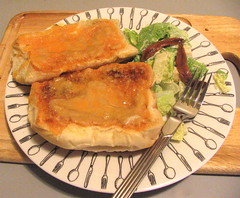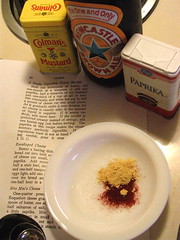The Welsh Rabbit experiment

Kristen and I gathered at the house tonight to make our Welsh Rabbit. Kristen brought Caesar salad to eat along with the “rabbit.” Jason was there to help eat the food.
The recipe we decided to use, as I mentioned earlier, was from the Good Housekeeping Woman’s Home Cook Book, exactly 100 years ago in 1909. They claim that all the recipes in that book are triple-tested, so we are hoping that this well-tested recipe works for us. Here it is:
A Really Digestible Welsh Rarebit
Melt one tablespoon of butter, add one-fourth of a teaspoon of salt and paprika, half a teaspoon of dry mustard and one-third of a cup of ale or beer. Stir constantly, and when hot, put in half a pound of cheese cut into small pieces. As it gradually melts it may thicken, for no cheese is exactly alike in the amount of liquid it requires. If it seems too thick, add more beer. If the rarebit is preferred creamy instead of stringy, add one beaten egg just before serving. The paprika in this recipe makes the cheese mixture perfectly digestible. If the regulation toast is not at hand for serving rarebit, pour it over saltines.–I. G. C.
This is not too difficult a group of ingredients to assemble. For the cheese, we picked up some Coastal Rugged Mature English Cheddar Cheese at Costco, and it’s really tasty stuff. Yum. For the ale, we got Newcastle Brown Ale. For the toast, we had some rolls from the local bakery — probably not exactly what was intended, but they were fresh and seemed as if they’d make fine toast. I got all the ingredients together, sliced the rolls and put them on a baking sheet, turned on the oven to toast the rolls, and was ready to start cooking.

I melted the butter, and then added the spices and beer. So far, so good. I wanted to get the rolls toasting so they would be perfectly toasted right about the time the sauce was done. But first, I put the cheese in the pan. This was probably a miscalculation. As I stirred the cheese, Kristen opened the oven to put the rolls under the broiler, and… the oven was cold.
Broken, that is. The knob had been turned on correctly, but nothing happened. I continued stirring the cheese, and the sauce looked about perfect… but we had nothing yet to pour it on. Jason came in and twiddled with the oven and got it to come on. Then it turned itself off. Then Jason got it to go back on again. The rolls were finally toasting… and right before our eyes, the cheese sauce started to separate. We cooked it too long, I think.
We added the beaten egg as the recipe optionally calls for, but we still had an ugly-looking stringy mess. Smelled good, though.
Shortly after we poured it on the toasted rolls, sort of. The thickest parts sort of glopped on. Kristen said it was “unappetizing.” We dished up our salads and settled down to eat.
The verdict:
Wendi: Thought it was ugly, and obviously not what it was supposed to look like, but it actually tasted pretty good anyway. Kind of salty, though. Would be willing to try it again.
Kristen: Hated it. Would not try it again. Thought it was too salty.
Jason: Liked it and would definitely eat it again. Enjoyed the leftover brown ale with it, too.
If I try this again, and I probably will, I will probably just toast the bread in a toaster, and heat the sauce under much lower heat, so it would not cook as quickly. Since it was a chafing-dish meal in the first place, I really should have done that all along. (What was I thinking? This was pure cook’s error. I would have gotten away with it if not for those meddling kids if I’d taken the sauce off the burner as soon as it looked right, though.) Also, I would probably not add all the salt in the beginning, and would salt to taste a bit later, which might help with the saltiness Kristen and I noticed. The aged cheddar seemed particularly salty in flavor to start with. This may be something that varies with different cheeses, I think. Other recipes I’ve seen include a little flour; I wonder if that would make the sauce a bit more manageable.
Having anchovies in the Caesar salad with it did not help as far as saltiness is concerned! Something to balance out the salt would be nicer as a side dish. Maybe a sweeter salad dressing?
I think one of the reasons that this dish has fallen by the wayside in recent years is the fussiness of making the cheese sauce. The average American household, sadly, is probably more likely to open a can, or just have a toasted cheese sandwich when it comes down to it.
(Psst — here’s a page with some lovely photos of what the Welsh Rabbit should really look like. If I’d gotten ours off the burner a little sooner, it would have looked like that too.)
